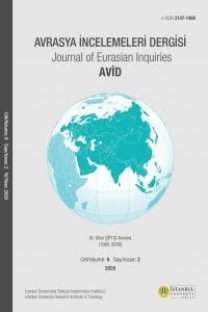Orta Asya’da Çağdaş Rekabet: Fırsatlar ve Zorluklar
Contemporary Rivalry in Central Asia: Challenges and Opportunities
Central Asia, CARs, geo-political rivalry economic connectivity,
___
- ANWAR, Zahid. “Development of Infrastructural Linkages between Pakistan and Central Asia”, A Research Journal of South Asian Studies, 26, no.1 (January-June 2011): 103-115.
- BEEHNER, Lionel. “U.S. Military Bases in Central Asia”, Council on Foreign Relations, 26 July 2005. https:// www.cfr.org/backgrounder/asia-us-military-bases-central-asia.
- BRADSHER, Keith. “Chinese Company to Buy Kazakh Oil Interests for $4 Billion”, The New York Times, 22 August 2005. https://www.nytimes.com/2005/08/22/business/worldbusiness/chinese-company-to-buykazakh-oil-interests-for-4.html.
- BRZEZINSKI, Zbigniew. The Grand Chessboard. New York: Basic Books, 1997.
- BP STATISTICAL REVIEW OF WORLD ENERGY, 21 November 2019. https://www.bp.com/content/dam/ bp/business-sites/en/global/corporate/pdfs/energy-economics/statistical-review/bp-stats-review-2019full-report.pdf. Encyclopedia Britannica. Heartland, 21 November 2019. https://www.britannica.com/place/heartland.
- FARCHY, Jack and KYNGE, James. “Map: Connecting central Asia”, Financial Times, 10 May 2016. https:// www.ft.com/content/ee5cf40a-15e5-11e6-9d98-00386a18e39d.
- GORDEYEVA, Mariyya. “China buys into giant Kazakh oilfield for $5 billion”, Reuters, 07 September 2013. https://www.reuters.com/article/us-oil-kashagan-china/china-buys-into-giant-kazakh-oilfield-for-5-billionidUSBRE98606620130907.
- HABERTURK HOME PAGE. “Baku-Tiflis-Kars Demiryolu Hattinda İki Yılda 275 Bin Ton Yük Taşındı, HaberTürk, 27 Ekim 2019. https://www.haberturk.com/baku-tiflis-kars-demiryolu-hatti-nda-iki-yilda275-bin-ton-yuk-tasindi-2534819-ekonomi.
- HUNTINGTON, Samuel P. “The Clash of Civilizations?”, Foreign Affairs 72, no.3 (Summer 1993): 22-49. JHA, Martand. “India’s Connect Central Asia Policy”, The Diplomat, 02 December 2016. https://thediplomat. com/2016/12/indias-connect-central-asia-policy-2/
- KHETRAN, Mir Sherbaz. “Economic Connectivity: Pakistan, China, West Asia and Central Asia.” Strategic Studies 36, no.4 (Winter 2016): 61-76.
- KORT, Michael. Nations in Transition: Central Asian Republics. New York: Facts On File, Inc, 2004.
- KOZHOKIN, Evgeny. “Geopolitical Importance of Central Asia: Russian View”, Strategic Analysis 33, no.4 (July 2009): 478-482.
- MUNIR, Muhammad and SHAFIQ, Muhammad. “Geostrategic Significance of Wakhan Corridor for Afghanistan, China and Pakistan”, Margalla Papers. (2018): 203-215.
- PILLALAMARRI, Akhilesh. “The United States Just Closed Its Last Base in Central Asia”, The Diplomat, 10 June 2014. https://thediplomat.com/2014/06/the-united-states-just-closed-its-last-base-in-central-asia/.
- PEIMANI, Hooman. Conflict and Security in Central Asia and the Caucasus. California: ABC-CLIO, LLC, 2009.
- RAUF, Servet. “Changing Geopolitical Dynamics in Central Asia: Causes and Effects.” Strategic Studies 37, no.4 (Winter 2017): 149-165.
- SNYDER, Jed C. After Empire: The Emerging Geopolitics of Central Asia. Washington, DC: NDU Press, eds 1995.
- THE ECONOMIST Online Page. “At the periphery: India in Central Asia”, The Economist, 04 January 2019. http://country.eiu.com/article.aspx?articleid=747505258&Country=India&topic=Politics &subtopic=Forecast&subsubtopic=International+relations&oid=1437529527&aid=1.
- US DEPARTMENT OF STATE Web Page. C5+1 Fact Sheet, 22 September 2017. https://www.state.gov/ c51-fact-sheet/.
- Yayın Aralığı: Yılda 2 Sayı
- Başlangıç: 2012
- Yayıncı: İstanbul Üniversitesi
Bağımsızlık Dönemi Kırgız Tarih Yazımına Kısa Bir Bakış
Orta Asya’da Çağdaş Rekabet: Fırsatlar ve Zorluklar
Bozkır Folklorunun ve Müziğinin Bin Yılı
Ahmet Bey Ağaoğlu’nun Gazetecilik Faaliyetleri (“Kaspi” Gazetesinde Yayımlanmış Yazılar Üzerine)
Ermenistan'ın Azerbaycan'a Karşı Askeri Saldırısı: Esir ve Rehinelerin Haklarının İhlali
“Bulgaristan ve Bulgaristan Türkleri 1878-1938
Taşkent Hanlığı’nda İlk Rus Elçisi Dmitriy Telyatnikov’un Misyonu ve Faaliyetleri (1797)
1924-1928 Yılları Arası İstanbul Şehremaneti Mecmuası’nda Şehircilik Açısından Su Konusu
Ermenistan'ın Azerbaycan'a Karşı Askeri Saldırısı: Esir ve Rehinelerin Haklarının İhlali
